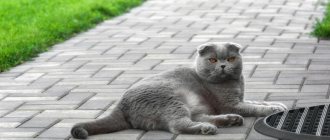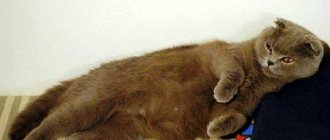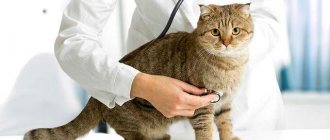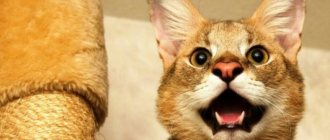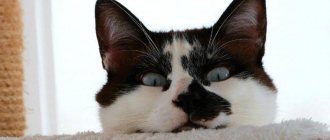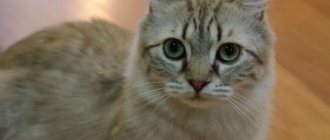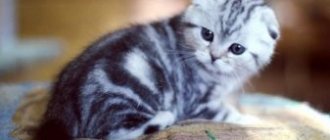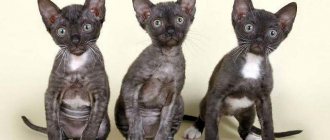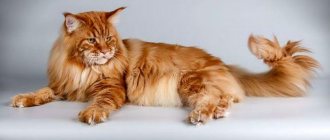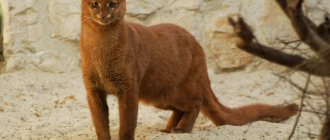Crossing Scottish cats to continue a high-quality breeding line should only take place under supervision and according to the rules approved by international felinological clubs.
In this regard, inexperienced owners have questions about what needs to be done to ensure that their pet has healthy offspring. Let's learn how to properly organize mating of Scottish Fold cats at home.
The right age for mating
Scottish Folds belong to a group of fairly robust medium-sized cats. Like other animals, they enter sexual maturity at 8-9 months. But by this time, the female’s young body has not yet become stronger and pregnancy during the first or second heat will greatly affect the development of the pet. Therefore, a Scottish cat can be bred for the first time at the age of 1.5 years.
A Scottish Fold cat may be younger than his chosen one, but for the first mating it is still worth choosing a partner with experience. It’s very bad when they both don’t have practical skills and don’t know which way to approach each other. In addition, the cat at the first mating usually begins to scratch, lie on her side and is not able to understand what she needs to do. In this case, you will need the help of an experienced instructor.
Important! If owners do not plan to use the Scottish Fold for breeding, it is recommended to spay or neuter him.
Re: Is it possible to cross relatives?
There is information that even if there was a casual relationship, the father covered his 2-month-old daughter, the baby did not develop well, 1 of the babies died after birth, and the second one grew up very small. The second case, when after such mating a completely healthy-looking chinchilla was born, was not large. , and after 1.5 years he unexpectedly fell ill and died. I had an inbreeding guinea pig (given as a gift), he had epilepsy, I had to be euthanized, although the animal was not a year old. I think from purely human considerations one can guess that such connections do not lead to anything good, especially since there are very inexpensive animals for sale, and even some are offered for exchange.
Who can breed a Scottish Fold cat with?
The issue of choosing a mating partner in the Scottish Fold group plays a major role. It's all about complex genetics, which affects the health of the offspring, their immunity and compliance with breed qualities. Breeders have never been able to achieve sustainable results when breeding fold-eared cats.
Small flaws in the breed remain, but negative consequences can only be avoided if Scottish Fold cats are bred according to the rules, even at home.
Fold is caused by the presence of a simple dominant gene FdFd in the genetic map of the animal.
The very first Scottish Fold cat was bred with ordinary cats. As soon as the group expanded and boys with drooping ears appeared, they were also included in the breeding plan.
Due to inbreeding (closely related mating of mother and sons or brothers and sisters), animals developed problems with joints and bones. It was possible to breed Scottish Fold cats with ordinary cats, but in this case the breeders would get both straight-eared and fold-eared children. And the experimenters really wanted all the kittens to be real folds.
All hereditary diseases were then attributed to intrabreed mating, and almost put an end to the future fate of the Scottish Fold. Later, the Americans abandoned the idea of producing 100% of the offspring with the auricle mutation, and began to cross both lines (straight-eared and curved-eared), thereby rehabilitating the unique animals. They developed a strategy, approved standards and launched the mass breeding of Scottish fold cats at home and in nurseries.
Consequences
Kin breeding has its strengths and weaknesses. The advantages include the ability to quickly identify the desired characteristics of the breed, consolidate stable traits, and obtain information about the advantages and disadvantages of the breed, including genetic diseases. Disadvantages include receiving both the desired dominant genes and harmful ones, reducing the vitality of the breed, and deformities. That is, undesirable traits are fixed - so-called inbred depression occurs.
The result is the need for strict culling of kittens (sometimes up to 80%). When it is undesirable to cross too close relatives, an option would be mating with animals of a breeder who is working on similar problems, or parallel breeding of several lines, the individuals of which are then mated. These options have significant disadvantages for breeding work - they do not allow you to quickly obtain information about the characteristics of the breed, because 98% of homozygosity in the 16th generation is achieved after mating along the closest line: parents and children or siblings (sisters and brothers). If you mate cousins, you can achieve only 65% homozygosity. An ill-conceived selection strategy can have dire consequences - a decrease in vitality and fertility leads to the extinction of an entire line.
Why you can’t cross a fold-eared cat with a fold-eared cat
It is precisely in the plane of mating of two fold-eared parents that all the negative genetic consequences in kittens appear. It was proven first experimentally, and later scientific evidence appeared, that all congenital health problems in Scottish cats occur precisely because of this configuration.
Initially, it was believed that the FdFd gene, which is responsible for lop ears, exists in an autosomal dominant form. Later, the nature of his partial dominance was revealed, which changed the entire original concept.
- When mating two fold-eared FdFd, the heirs exhibit all the genetic defects - deformation of the tail and limbs, fusion of the vertebrae and other diseases.
- Crossing a fold-eared FdFd with the same fold-eared dog, but with Fdfd or fdFd, eliminates any health problems and produces offspring with curled ears.
- It is possible to mate Fdfd Fold (fdFd) and Scottish Straight fdfd. In this case, “mixed” children are born.
It turns out that you can breed a straight-eared cat (straight) with a fold-eared cat, and vice versa, there will be no negative impact on the health of the kittens in such a union. But when two Scottish folds are mated, you need to be sure that at least one of the parents has the homozygous Fdfd allele (fdFd).
There is one more. Some kittens have ears that fold first and later rise, although in fact the animals have genes for lop ears. A gradation has been developed according to which the Scots can have 1, 2 or even 3 folds. In the latter case, the auricle is 100% guaranteed to be adjacent to the head and there can no longer be any external changes to it. But the first option is the riskiest. Visually, the animal looks straight-eared, although it has the lop-eared gene.
If crossed with a Scottish Fold, the offspring will most likely get hereditary diseases. So when breeding straight-eared Scottish Straights, you need to have complete confidence in the consistency of the genetics and appearance of the pets.
Is it possible to have cats with relatives?
Inbred matings between Scottish Folds and Scottish Straights are strictly unacceptable.
They are possible only in exceptional cases, for example, to obtain a new color. Because of such constant matings, I kicked the lady out of the club. I know how such matings end. For the British, inbred matings are acceptable if they are justified by securing the desired trait. Consolidation of excellent breed characteristics according to GREAT-GRANDFathers is only welcome.
Having studied the habits of people, I prefer the company of British cats.
The wider you open your arms, the easier it is to crucify you. Nietzsche.
God is with us!
God said: “Fear the tears of a person offended by you, because he will ask me for help, and I will help.”
For the British, inbred matings are acceptable if they are justified by securing the desired trait. Consolidation of excellent breed characteristics according to GREAT-GRANDFathers is only welcome.
Proper organization of mating
The rules for mating Scottish cats consist of the following points:
- Mandatory vaccinations and treatment against parasites are carried out at least 15 days before mating.
- Cats must be healthy, free from infectious foci and open wounds.
- It is necessary to trim the animals' claws so that they will not be able to inflict deep scratches on each other.
- You should not pre-bathe your pets so as not to disturb their natural scent.
- At least a week before the intended mating, cats are not given medications (especially hormonal ones).
Pet owners also need to decide on whose territory the Scottish breeding will take place in order to prepare the premises. Traditionally, the cat plays the role of “master,” but this issue can be discussed.
If the “groom” is already untied and has experience, then he almost doesn’t care in what territory the mating will take place. The same rule applies to cats - at first they do not yet know what to do, but later they cope with the task perfectly in any room.
Important! The mating process lasts for several days. At this time, the owner of the apartment must control the behavior of the cats and ensure that they do not harm each other.
Is mating between close relatives justified?
Is mating between close relatives justified?
Post number: #1 Olchik » 05 Nov 2009, 15:21
Post number: #2 Oliva » 05 Nov 2009, 15:57
Is mating between close relatives justified?
Post number: #3 Keltic Prince » 05 Nov 2009, 18:07
Is mating between close relatives justified?
Post number: #4 Olchik » 05 Nov 2009, 18:57
Is mating between close relatives justified?
Post number: #5 Oliva » 05 Nov 2009, 19:13
Is mating between close relatives justified?
Post number: #6 Olchik » 06 Nov 2009, 11:31
Is mating between close relatives justified?
Post number: #7 Keltic Prince » 06 Nov 2009, 12:03
Who's at the conference now?
Currently browsing this forum: no registered users and guests: 1
Post number: #1 Olchik » 05 Nov 2009, 15:21
How does the mating process work?
Estrus in a Scottish cat lasts from 5 days to 1.5 weeks. At this time, her behavior changes, she shows signs of sexual desire, worries, rubs against the owner’s legs, shows excessive affection or, conversely, becomes aggressive.
Cats meow very annoyingly, their behavior becomes more nervous, they also mark their territory with an odorous secretion.
Mating of Scottish Fold and Straight-eared cats is prescribed on the 2-3rd day of estrus. The process goes like this:
- Animals are introduced to the common space.
- Depending on whose apartment the “newlyweds” are meeting, their behavior varies. The owner always waits until the guest gets comfortable in the new place and can pay attention to the other party. It is important that everything goes naturally. Usually it takes from a couple of hours to half a day to meet animals.
- Partners begin to sniff each other and show signs of attention.
- The cat may not let the cat get close to her, hissing and fighting back with her paw. In this case, the boy retreats, but with each new attempt the animals come closer and closer.
- The cat emits an inviting meow and takes a characteristic pose - bends down on its front legs, raises its butt higher and lifts its tail.
- At a convenient moment, the cat makes a “mount” - it climbs up, clasps the body with its front legs, and presses the cat’s withers with its teeth. She, in turn, does not interfere with sexual intercourse and moves her tail to the side.
The mating moment itself lasts 10-25 seconds, and then the animals disperse. The cat and cat rest, and then the cycle repeats again. There can be 8-10 such iterations per hour, and the entire crossing process continues for several days.
Important! Under normal conditions, a 2-3 day mating of healthy Scottish Fold cats provides an almost 100% guarantee of pregnancy and high-quality offspring.
Lambkin
The result of crossing a Munchkin and a Selkirk Rex. This is a rare breed of cat that has short legs and curly hair. The animals have a slightly elongated body and thick short legs, with the hind legs being longer than the front ones. Their head is wedge-shaped, cats have large ears, round eyes, most often blue, but any bright shades can also be found.
Lambkins have a soft, plush coat with curly locks that resembles the coat of a lamb, which is how the breed gets its name. These cats love affection and being the center of attention, they adore all family members and will never offend a child. Pets are very smart and get along well with other pets. The lack of official recognition is due to a double mutation in cats, which can lead to problems with the musculoskeletal system.
Possible difficulties
Compliance with all of the above rules assumes the natural course of events. In normal condition, cats get along well with each other and will not cause trouble to their owners.
Minor deviations may occur in the following cases:
- One or both partners are taking part in mating for the first time - it will take them much longer to overcome the barrier of inexperience, but experts advise avoiding such pairings. The largest percentage of failures is in this situation.
- If one or both partners show aggression, it is recommended to introduce them at a distance (in cages or in a room separated by a net) and bring them together only when Scottish cats get used to each other.
- The owner of the apartment will have to keep the animals under control at all times and prevent them from causing mutual injuries.
- Females traditionally dominate males, and this creates difficulties when mating pets that are already familiar and live in the same territory.
- Additional problems can be caused by loud sounds, noise, the presence of strangers in the apartment and any other reasons that distract Scottish cats from mating and create a stressful situation for them.
If there is the slightest concern about the ability of the owners to independently organize crossing (or difficulties begin in the mating process), it is best to invite a specialist who will help the animals and monitor their condition.
Although rare, there are cases where Scottish fold cats cannot mate on their own and are left without offspring. It must be remembered that this breed does not have centuries of experience in survival and reproduction; it was created by people, and therefore, without their participation, it loses its independence.
Family Relationships or Inbreeding
Please tell me, is it permissible to mate a brother and sister? Alina
If the word inbreeding is familiar only to specialists, then everyone has probably heard incest What is this? Simply put, incest is a relationship between close relatives.
But this is terrible! For people - perhaps, but for animals - a common thing. Moreover, all breeds were bred this way.
So what happens, you can easily breed any animals, even those who are related by blood?! Well, no, genetics and selection are a “delicate matter”, they require a careful and competent approach, otherwise something like this can be done...
Let's look at the question in a little more detail, but not too deeply, just to understand the essence.
In general, breeding can be carried out by outbreeding (crossing of unrelated individuals), linebreeding (crossing “along the line”, that is, mating of distant relatives who have a common ancestor somewhere in the 3rd or 4th generation) or inbreeding (crossing of close relatives (sometimes close (incest) ), close, moderate and distant)).
Inbreeding in cats and its goals
Each breeder, working with a breed, must decide which cats and males need to be selected for mating so that the resulting offspring have certain characteristics. This process is called selecting pairs for crosses.
Purebred breeding is divided into two types: outcrossing
- a system of unrelated mating of animals within a breed, and
inbreeding
- mating of related animals with each other to consolidate valuable characteristics of the breed.
What is the genetic essence of inbreeding?
All modern cat breeds are heterozygous for many genes. This means the following. The zygote - a fertilized egg - receives one complete set of genes from both the father and the mother, so that it has a double set of them.
If both genes responsible for a given trait - one from the father and the other from the mother - are identical, then this condition is called homozygous for this gene, and an individual homozygous for this gene will develop from the egg. If the genes of the equivalent pair, for example, those determining the formation of black hair pigment, are different (say, the father passed on the black color gene C, and the mother passed on a modified, for example, Himalayan, cs gene), then the individual will turn out to be heterozygous for this gene (Ccs).
In the latter case, the black color gene is dominant, and the animal will be externally (phenotypically) black, but will be a carrier of the recessive (hidden) Himalayan gene. If such a heterozygous animal - let it be a black cat, a carrier of the Himalayan gene - is crossed with its own sister, also a black cat, carrying a hidden Himalayan gene, then splitting will be observed in the offspring: part of the offspring will be black in color (CC - homozygous, and Ccs - heterozygous genotypes), and the other part is Himalayan (сссs homozygous genotype). This happens because when crossing this black cat with his black sister, their gamete sex cells (sperm and egg) - carrying a single set of genes, will be found in all four possible combinations: C from cat and C from cat, C from cat and cs from cat, cs from cat and C from cat, cs from cat and cs from cat.
Therefore, with a probability of 1/4, two Himalayan genes (one from the father, the other from the mother) will converge in one zygote and give a homozygous Himalayan genotype and, therefore, a Himalayan phenotype in some kittens of the litter. The other part of the litter, with the same probability of 1/4, will be homozygous for the solid black gene (CC). Thus, the genetic essence of inbreeding comes down to the process of decomposition of a population into lines with different homozygous genotypes. Since during inbreeding, genes that were in a heterozygous state pass into a homozygous state, in the next generation, when crossing homozygous animals of the same color, no splitting will be observed.
In this way, with the help of inbreeding, hidden traits are identified, desired traits are consolidated in generations, and stable genetic lines are created. But you need to understand that the consolidation of any characteristics is not an automatic consequence of inbreeding. Obtaining high-quality animals through inbreeding is, first of all, a competent policy of the breeder, who, along with inbreeding, also selects the right pairs.
Based on an analysis of the animal's pedigree, it is possible to qualitatively assess the degree of inbreeding, which is expressed by the presence of common ancestors on the maternal and paternal lines. Inbreeding is recorded using Roman numerals that correspond to the ranks of the ancestors. The count starts from the parent, i.e. I - parents, II - grandfathers, III - great-grandfathers, IV - great-great-grandfathers, etc. If a common ancestor is repeated in both the maternal and paternal parts of the pedigree, then its occurrence in the maternal pedigree is indicated first, and then, after a dash, in the paternal pedigree.
Son-mother will be recorded I-II, daughter-father II-I, sister-brother II-II. This is close inbreeding. Such inbreeding is used in cases where it is necessary to identify producers who are carriers of lethal, semi-lethal and other undesirable genes. Such a check must be arranged for those producers on whom we plan to inbreed animals in our nursery in the future. Grandmother-grandson will be recorded I-III, granddaughter-grandfather III-I. This degree of inbreeding is considered close. Cousins III-III. This is moderate inbreeding. As well as III-IV, IV-III, IV-IV. Distant degree of inbreeding IV-V, V-IV, VV.
This system for recording the degree of inbreeding is considered universal and very convenient. There is no need to explain to another breeder by nickname who is related to whom in the pedigree of your animal, and is also very convenient when drawing up a long-term breeding program.
Inbreeding is a very powerful weapon in the hands of the breeder. But he also has another side. Inbreeding creates homozygosity not only for the genes we need. Harmful genes responsible for genetic abnormalities, hereditary diseases, and deformities can also become homozygous.
Using inbreeding in a breeding program is a very serious decision. Breeders who strive to make so-called “easy money” from selling as many kittens as possible will never put inbreeding into practice.
A breeding program based on inbreeding does not aim to ensure maximum survival and vitality of all offspring. Its goal is to select the best, culling (for example, castrating) defective, weak and simply undesirable traits.
Thus, during inbreeding, when the genotype is decomposed into homozygous lines, harmful recessive genes appear and are removed from further breeding, and all “good” genes and their combinations are fixed in a homozygous state and left for further generations.
Thus, inbreeding in the hands of a breeder is a way of removing the load of harmful mutations from the genotype, on the one hand, and creating the necessary combinations of valuable genes and traits, on the other. In addition, thanks to homozygosity, the homogeneity necessary for breeding any new breed is created, meeting the requirements of this breed, and the corresponding valuable traits are fixed in the offspring.
Poodlecat
The Poodlecat breed was developed by crossing the Norwegian Forest Cat, Maine Coon, Devon Rex, Scottish Fold and Somali cat. Features include a wavy coat and drooping ears. These cats have a medium build and weigh from 2 to 6 kg. The body of the animals is densely covered with hair, they have well-developed muscle tissue, strong stable limbs with oval paw pads.
These cats have a round head with a wide forehead and large, far-set ears, a short muzzle with round eyes of different shades. The coat is smooth, the curls can be either curls or waves. Poodlecats have a friendly and very loyal character, they love affection, find a common language with other pets and absolutely cannot stand loneliness. The breed has two striking mutations that affect the cat's health - they are very prone to allergies.
